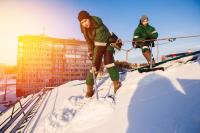 Add My Company
Add My Company
Sign In

Many parts of the UK have experienced snow in the past week or so, with some seeing a significant amount of snow building up recently. While it can make a place look very pretty, it’s important to check your home or work premises for any signs of damage once the snow has melted.
In some cases, you might not even get until the snow melts to spot any damage, as one shopping centre in Bath recently discovered.
Somerset Live reported that the Corridor, off Bath High Street, was closed on 1 February after parts of its glass roof collapsed under the weight of the snow.
Glass and brickwork from the roof fell some 20 to 30 feet, landing in the pedestrianised area outside some of the shops that are based in the centre. No one was injured in the incident, but it has been closed indefinitely while repairs are carried out.
Businesses based in the centre are concerned about a loss of custom as a result of the closure, but with sections of broken glass remaining in the roof overhead, there is no other safe option until repairs have been completed.
A blog post for Summit Engineering offered some advice about when to be concerned about the amount of snow piling up on your roof, as well as some of the signs to look out for that indicate a roof might be likely to collapse.
Firstly, the company pointed out that, as a general rule, until you have two feet or more of snow on your roof, you’re unlikely to have any issues, especially in modern buildings. Should snow build up to this kind of level, you need to look at ways of removing it.
One indication that something might not be right with your roof is any signs of water damage on your upper ceilings or on the walls in upstairs rooms. According to Summit Engineering, in warmer conditions this is a common sign that there are issues with the roof, but these may be replicated even in colder weather.
If your building has eaves, you could also be at risk of an ice dam forming. These are created when the snow melts on the upper levels of the roof, but re-freezes into ice as it reaches the eaves because this section of the roof isn’t heated.
The ice can create pools behind it, and it’s these pools of water that can do the damage by seeping under tiles and roof shingles. If you’re concerned this might have happened, check your loft and upstairs rooms for any signs of water damage.
You might need help with lead flashing repair or to replace some tiles if the cold weather has caused this kind of issue.
One thing to remember though is that you should always get assistance from professionals to remove a build-up of snow on your roof, and if you’re concerned the winter weather has caused any damage then get a professional to assess it as soon as possible.
You may be able to spot issues from the outside, or indoors such as with the damp patches mentioned above, but it’s always advisable to get a professional opinion and assistance with any repairs to ensure your roof is ready for the next spell of cold weather.
For more information on MAKE SURE YOU CHECK YOUR ROOF FOR SNOW DAMAGE talk to Polycote UK
Enquire Now
List your company on FindTheNeedle.

